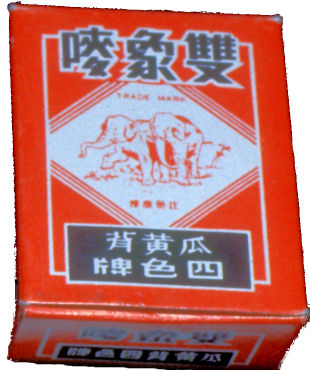
Purchased from a market vendor in Los Angles in 1981, this partially illustrated deck was manufactured by Guan Huat Ltd. in Hong Kong.
No printed information about the game was contained in the box. According to Dr. Keng Ho Pwee of Singapore who was a Visiting Scholar in Canada and viewed the collection, these cards are a pack of Si Sek or four-colour playing cards. These are also known as Chess cards because the characters are from the Chinese Chess (xiangqi) pieces. They are used for playing a rummy type game. Mr. Nick Corduan of Taylor University in Fort Wayne, Indiana, in an e-mail referred to these cards as a Si Se Pai deck, the "Four Color Cards" game.
The Webpage about Xiangqui (pronounced shang-chee), the Chinese version of the game of Chess appears in the "Virtual Chess Exhibit".

The cards are enclosed in a flap-top box (illustrated on the right). The box is 5.4cm long x 4.4cm wide x 2cm thick. On the front are two stylized elephants in the diamond-oval design. There is an English language Trademark on the box, as well as the Chinese characters. There are 228 cards in the box. Each card is made of paper and is 5.1cm long x 1.8cm wide. The backs of the cards are blank. There are six suits - yellow, red, blue, white, green, black. Within a frame on each card Chinese characters indicate the type of card. Pictured below are four of the cards in the deck. The cards shown are:
| Xian (Minister) | Pao (Canon) | Ju (Chariot) | Ma (Horse) |  |
 |
 |
 |
|---|
Another playing card game from the south China coast is the game of Luk Fu, or The Game of Six Tigers which may be of interest to "surfers". A Website in England that offers information about this game is Liuk Fu. Surfers who wish to return to this page after visiting that site must use their Browser's Back Button.
For information on the origin and history of Chinese playing cards in the Archive, click on the Wilkinson Page in the left menu.
NOTE: This page was originally created and posted on the Web on March 12, 1995. Subsequently it has been modified and periodically updated. Last update: June 11, 2010